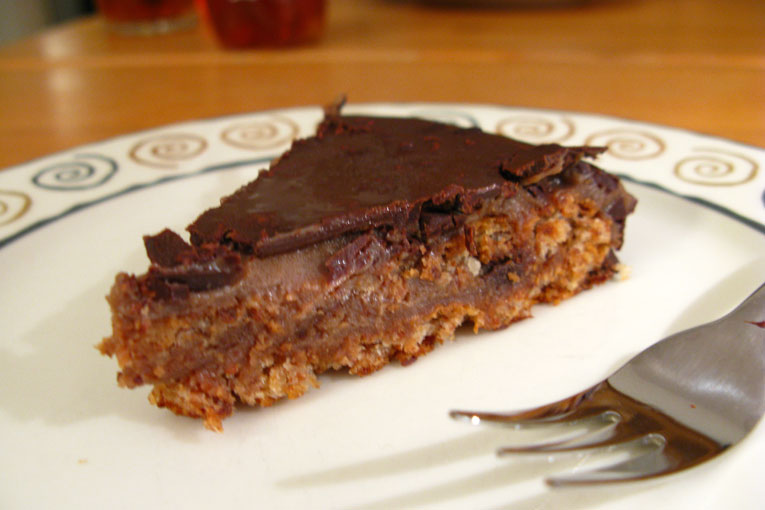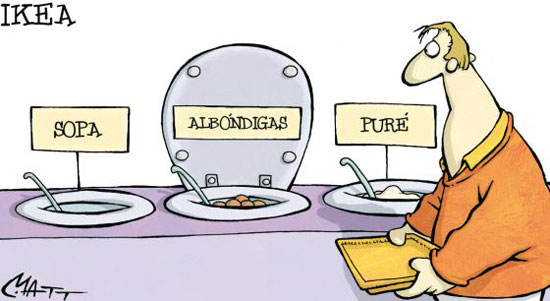
 Foto: Jemimus (Flickr) La Tarta Mörck Choklad servida als restaurants d’Ikea, un dels dolços que apareix a la premsa com a portador de bacteris fecals. |
||
|
It is not unusual finding science news articles in newspapers with provocative and sometimes even sensationalistic headlines. But, do these headlines match reality? Is the information confirmed or is it merely used to attract the readers’ attention? Unfortunately, the news often shows a lack of rigour. Facts, processes and conclusions may vary depending on the medium chosen. Information is mixed, confusing and often contradictory. The coverage of the very recent IKEA scandal is a good example that illustrates this. Two batches of a cake made and sold by the Swedish supplier were found to be contaminated by bacteria, according Chinese customs controls. Only reading Spanish newspapers, we can find many different microorganisms involved in the scandal, figures of destroyed products vary in thousands of kilograms, etc. Altogether, if you try to get an overview of the situation using different sources you end up having no clue of what is going on. Let’s make a review of the facts. In December 2012, the Chinese government detected two batches of cakes contaminated by coliform bacteria. These cakes were to be served in all Ikeas around the world. Spanish newspapers started writing about it on March 5, 2013, almost four months after it was detected, following the news regarding the meatballs the company serves in its restaurants. These meatballs —the restaurant’s star product— included horsemeat of dubious origin and apparently had not been labelled as such. Therefore, there was a double fraud: wrong labelling and difficult product traceability. Headlines do not help the readers to form an opinion regarding actual facts. Actually, there are a few journalists whose writing is so misleading that should be punishable by law. The most important Spanish newspapers included these headlines (March 5, 2013):
Surfing the Net one can find completely nonsensical headlines. For example, Noudiari.es 24 horas de información. Eivissa y Formentera (covering for the islands of Ibiza and Formentera) published on March 24: «Ikea withdraws a cake containing faeces», although in the main text they talk about «coliform bacteria common in human faeces». This headline leads you to think something quite different. Terra.es published «Faecal matter found in a batch of Ikea cakes» (March 5, 2013). «Faecal matter» is only a synonym of «excrements». |
«Facts, processes and conclusions may vary depending on the medium chosen» |
|
 Cartoon published in El País (March 8, 2013). It clearly evidences the confusion around the two news items: the fraudulent meatballs inside a toilet refer to the «faecal bacteria» found in cakes according to the Chinese government. What’s the story then? Contaminated meatballs or Polish horsemeat pies? By the way, the store started selling meatballs again on March 23, and cakes were 10% off. |
«Headlines do not help the readers to form an opinion regarding actual facts» |
|
|
Chinese customs authorities claim that they did find a high number of intestinal bacteria in the cakes. They did not specify the procedure followed to detect the problem nor what their quality standards are. Apparently, the source of contamination was Almondy, the Swedish company that makes the cakes for Ikea in 23 countries. According to some sources, it is likely that the contamination comes from a different factory —in the factory that provides chocolate for Almondy. Heads of the company claimed that their chocolate comes from a company whose «products are high quality products»: Nestlé, which, by the way, has not yet said a word regarding this issue. Others sources point to the workers’ hygiene, to the quality of the water used, breakage of the cold chain… What we know is that all allegedly contaminated cakes were destroyed. But, how many cakes were destroyed? Some articles claim that two tons were destroyed, while others assert that they were 1,800 kg, or 1,800 cakes (one cake weighs 350g, according to the label, if we calculate 1,800 times 350/400 g, then we get 630/720 kg). The contaminated cakes have not affected China because they were destroyed prior entering the country. According to Ikea’s sources, the coliform bacteria found are not Escherichia coli, although they did not clarify what bacterium it is. They also claimed that contaminated batches have not affected Spanish stores, but admitted that these cakes had indeed been sold in other European countries. But, did they reach Spanish stores? We cannot track the product since all contaminated samples were destroyed in Shanghai. This is why it is very difficult to identify where the bacteria came from and define their effects on our health. Coliform bacteria are a type of microorganism that can belong to different genera and not all them are faecal bacteria. Some of them can be found in water and soil. These cakes are sold in Ikea’s restaurants as desserts. Surprisingly enough, the press has identified these cakes with two different names and using two different images as well: Tårta Mörk Choklad —which contains almonds, dark chocolate cream and sprinkled peanuts— and Tårta Chokladkrokant —which contains almonds, chocolate, buttercream and caramel. According to European regulations, these kind of products undergo tests for the detection and enumeration of enterobacteriaceae (ISO 21528-2): Escherichia, Salmonella, Shigella, Enterobacter, etc. In order to detect these enterobacteriaceae, they take five samples of the product and find out whether there are coliforms in the sample or not within 24 hours. And within another 24 hours, if these coliforms are faecal or not. In short, we can draw three different conclusions. Firstly, it is hard work finding a newspaper article written with scientific rigour —terms are confused and there is a lot of sensationalism while some things remain unexplained. For example, news of the contamination broke right after the news of the meatballs containing horsemeat, but months after the actual facts took place. Sheer coincidence? Secondly, we still don’t know what type of bacterium was detected or its precedence. Lastly, and more importantly: we have to trust our immune systems as well as the sanitary controls products undergo. Otherwise… we are lost. Carmen López Valiente. PhD in Biological Sciences and teacher at IES Ausiàs March (Manises, Valencia). |
«We cannot track the product since all contaminated samples were destroyed in Shanghai. This is why it is very difficult to identify where the bacteria came from and define their effects on our health» |
|





